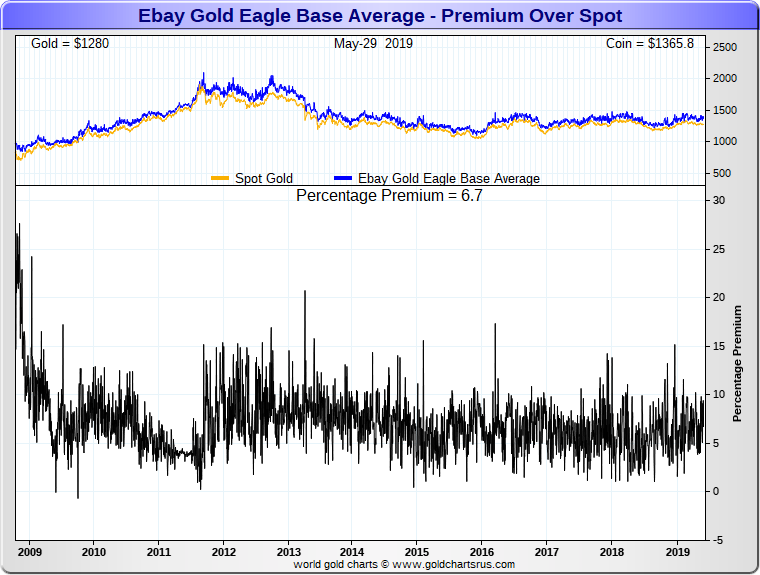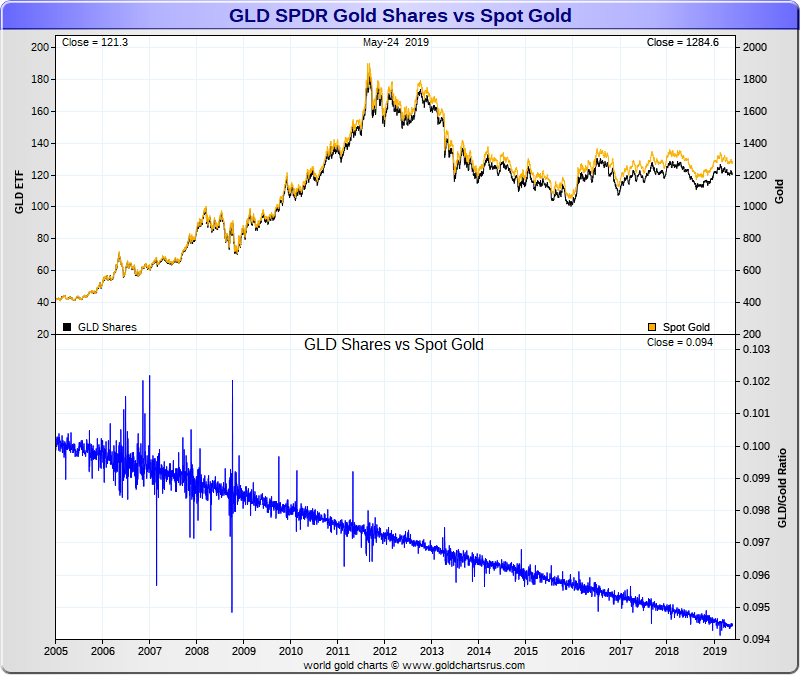Whether to invest in Gold via a Gold ETF derivative or directly through buying Gold Bullion outright is one that requires a few factors of consideration.
Risk tolerance, expenses, and time horizon all play into deciding which Gold investment vehicles make the best sense for you between Gold bullion and or Gold ETF exposure.
Most Gold ETF owners have never read the prospectus of equity they own much less understand the annual expenses and risks of such products. For short term trading, Gold ETFs may be a viable option.
Here we examine the most often purchased Gold ETF vs. Gold bullion investment vehicles; looking at their annual expense and risk profiles, as well as their past and present performances.
Gold Investing Timeframe
If a gold investor is making a shorter term trade or looking for a near term investment hedge, buying a gold ETF may be the most comfortable and cheapest option.
But it is not without expenses and risk trade-offs. Merely read any gold ETF prospectus, and you will come away knowing that the custodians and gold ETF managers typically indemnify themselves from virtually any responsibilities.
If the time horizon on your gold investment is medium to long term (2 years or longer), due to annual gold ETF fees, myriad counterparty risks, and lacking 24 hour 7 day per week liquidity; most longer-term gold speculators will likely benefit more by merely buying physical gold bullion investment-grade products outright.
Here you can find a list of some of the most popular gold bullion products we buy and sell.
Typical physical gold bullion buyers have medium to long term time horizons on their purchases and holding duration expectations. Physical gold bullion owners are most often not simultaneously derivative day-traders.
Most gold bullion buyers have a multitude of common reasons and motivations for their outright Gold bullion ownership. Many driving forces for investors to buy gold bullion, conflict with the vast majority of gold ETFs which are commonly available on equity and stock exchanges (thus have risks associated with the financial system as a whole).
Below we examine some of the costs associated with holding shares in the most popular Gold ETFs versus buying Gold bullion outright and holding it first hand and or using a fully insured non-bank Gold vault or depository service.
Aside from the hard costs and the annual fees associated, we look at the other features that make gold ETFs inferior to physical gold bullion ownership, such as:
- Can you visit and audit your precious metals?
- Do you know even where your fund's precious metals are also stored?
- Do you as an ETF shareholder even own outright any precious metals underlying the fund?
- Can you easily withdraw your very own physical bullion bars or coins?
- How did your gold ETF perform in the 2008 financial crisis (if it even existed back then), while many popular physical golf bullion product premiums reached +20% above the then fluctuating gold spot price?
--
Unlike the direct private gold bullion storage models offered here at SD Bullion, when you examine the overall fees of gold ETFs looking backward, you will inevitably find higher costs associated than even their supposedly simple upfront quoted “management fees.”
Commissions and also operating expenses are often added on in arrears, making total expenses for many gold ETFs much higher than what was perceived initially or quoted up front.
Also, note that the most substantial gold ETFs called GLD, only allows “Authorized Participants” to take physical delivery of Gold bullion from the fund.
Mostly these participants are only the largest approved commercial banks, billionaire institutional investors, institutional hedge funds, etc.
In other words, most retail gold investors cannot take physical delivery of any gold ETF mentioned below. For most, only some ‘approved’ or ‘authorized’ financial insiders can redeem physical gold bullion from the world’s largest gold ETFs. Choose accordingly.
Most gold bullion buyers believe precious physical metals owned outright offers them:
- A safe haven asset which preserves wealth over the long term and is easy to transfer title to loved ones on an intergenerational basis.
- A real portfolio diversification tool which when back-tested in our full fiat currency era is mathematically proven to hedge against many downside risks compared to other non-correlated asset classes (stocks and bonds specifically).
- A currently undervalued asset class compared to equities, bonds and t-bills, even real estate.
- A tangible defensive asset is protecting wealth against both record debt levels worldwide, potential inflationary or deflationary scenarios.
Protection from bank failures (e.g., bank bailouts, bank bail-ins, account freezes, and cash withdrawal rationing).
- A private asset which cannot go bankrupt with limited counter-party risks.
- A potentially revaluing asset class in a record low real interest rate yielding environment (e.g., ZIRP / NIRP) with other experimental and standard central bank policies which consistently devalue fiat currencies over the long term (e.g., QE, potentially MMT).
- One of the most liquid, easily tradable asset classes similar to most physical cash notes still accepted in commerce.
--
Gold Bullion vs Gold ETF Pros Cons
|
Gold Investment Vehicle |
Annual % Fees? |
Is it fully allocated to you and in what form? |
Are you able to visit and audit your holdings? |
Can you take direct delivery? |
|
Direct Gold Bullion Ownership |
0.00% |
Yes, fully allocated in your possession the gold bullion you choose to buy and hold long term |
Yes |
Yes |
|
Direct Gold Bullion Storage |
0.29% |
Yes, fully allocated and segregated for each owner |
Yes |
Yes |
|
GLD |
>0.40% |
No, only large Industrial bars |
No |
No, only "Authorized Participants" |
|
IAU |
>0.25% |
No, only large Industrial bars |
No |
No, only "Authorized Participants" |
|
SGOL |
>0.39% |
No, only large Industrial bars |
No |
No, only "Authorized Participants" |
|
PHYS |
>0.35% |
No, only large Industrial bars |
No |
Yes, minimum of 400 oz |
--
Gold Bullion vs Gold ETF Price Performances
Gold bullion has durations in time when price premiums for the highest demanded products.
For instance, the 1 oz American Gold Eagle Coin, for example, can and has outperformed all gold ETF derivatives over the past decade.
Gold vs Gold ETF vs Gold bullion SD Bullion
See in the chart below how in the 2008 financial crisis, one ounce American Gold Eagle coins where commonly being sold for over 20% price premiums above the fluctuating gold spot price.

It appears even currently the average prices for these most popular gold bullion coins are always being sold at single digit or more price premiums above the fluctuating gold spot price.
Indeed, at much larger price premiums than GLD shareholders are receiving if they currently go to sell their shares during limited trading hours.
Gold ETF vs Physical Gold at SD Bullion
The most popular Gold ETF trading under ticker symbol GLD only continues to diverge its ongoing price below the gold spot price.

There is no chance for retail GLD shareholders to make any premiums on the shares they own if the gold price falls under another short squeeze with tight supply and a massive demand scenario.
Gold ETFs vs Bullion Bottom Line
If you are a day traded and need a gold investment vehicle for short term trading, Gold ETFs are likely viable options.
Just know there are a myriad of counter-party risks and annual expenses associated with synthetic gold derivative investments.
If you have a longer-term time horizon with your gold bullishness, it makes better sense historically speaking to give gold bullion the vast majority of your gold allocation. And then hide and safe-keep your prudent gold bullion allocation for the long haul.
Thanks for visiting us here at SD Bullion.
***














